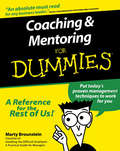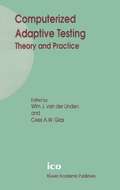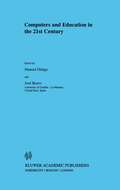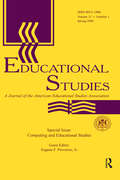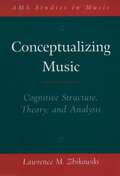- Table View
- List View
A Class Act: Changing Teachers Work, the State, and Globalisation (Studies in Education/Politics)
by Susan RobertsonThis book offers an original and challenging theoretical and empirical approach to mapping the changing nature of teachers' work historically and in the contemporary period. It is an attempt to understand how and in what ways teachers' work has changed following the demise of the post-war settlement and the imminent collapse of teachers' project of professionalism secured through solidaristic strategies such as unionism. Dr. Robertson argues that in order to understand these issues, a more rigorous set of conceptual tools around social class, occupational power and worker control is needed. The first two sections of the book set out to address that problem. The final section elaborates on the changing contexts and conditions for contemporary teachers more generally, and argues that structural and ideological changes within educational provision have led to differing capacities in the realization of class assets.
A Class Act: Changing Teachers Work, the State, and Globalisation (Studies in Education/Politics)
by Susan RobertsonThis book offers an original and challenging theoretical and empirical approach to mapping the changing nature of teachers' work historically and in the contemporary period. It is an attempt to understand how and in what ways teachers' work has changed following the demise of the post-war settlement and the imminent collapse of teachers' project of professionalism secured through solidaristic strategies such as unionism. Dr. Robertson argues that in order to understand these issues, a more rigorous set of conceptual tools around social class, occupational power and worker control is needed. The first two sections of the book set out to address that problem. The final section elaborates on the changing contexts and conditions for contemporary teachers more generally, and argues that structural and ideological changes within educational provision have led to differing capacities in the realization of class assets.
Coaching and Mentoring For Dummies (For Dummies)
by Marty BrounsteinIf you want to create a lean, mean, working machine in today’s environment you need a game plan for building employee morale and commitment. By coaching and mentoring your work force—instead of implementing staid traditional management techniques—you’ll start to see tremendous results. Regardless of where you find yourself on the corporate ladder and what level of authority you carry, what you and other managers share in common is the responsibility for the performance of others. Coaching and Mentoring For Dummies can open your eyes to this innovative way of managing and show you the best way to get the most out of those who work for you. Coaching and Mentoring For Dummies provides the foundation for understanding what business coaching is all about, and helps you gain or improve the coaching skills that drive employee performance and commitment. These skills, which serve as the main topics of this book, involve: getting employees to deliver the results you need; guiding employees to think and do for themselves; motivating employees to take on responsibility and perform effectively; and growing employee capabilities that lead to career development and success You’ll also discover how to: Use questions rather than commands Be a delegator, not a doer Complete performance reviews without anxiety Grow your employees’ talents Increase productivity and decrease turnover With Coaching and Mentoring For Dummies as your guide, you can start to put these techniques and tools to work for you and inspire your employees in ways you never imagined. From tried-and-true worksheets to tools that you can tailor to you own situation, this friendly guide helps you call all the right plays with regards to your employees. Forget about micromanaging! When you become a coach, you’ll be surprised by the tasks your group can perform.The fun and easy guide to today's hottest trends in management training, Coaching and Mentoring For Dummies shows managers how to take advantage of these state-of-the-art management tools -- without spending hundreds of dollars on training seminars! This book features Guidance on being a coach rather than a doer" and giving feedback in a positive way Advice on motivating, grooming, and growing employees Tips on tackling diversity issues, performance reviews, and other challenges Put these techniques and tools to work and inspire your employees in ways you never imagined. Forget about micromanaging! When you become a coach, you'll be surprised by the tasks your group can perform.
Collaboration--across Campus, Across Town, and With K-12 Schools: A Special Issue of the peabody Journal of Education
by Jill F. Russell Richard B. FlynnFirst Published in 2000. Routledge is an imprint of Taylor & Francis, an informa company.
Collaboration--across Campus, Across Town, and With K-12 Schools: A Special Issue of the peabody Journal of Education
by Jill F. Russell Richard B. FlynnFirst Published in 2000. Routledge is an imprint of Taylor & Francis, an informa company.
The Color of Teaching
by June GordonOne of the major concerns in education at present is how to recruit and attract more teachers from ethnic minorities. In an attempt to move beyond the superficial and simplistic responses as to why these students are not entering teaching this book presents in-depth interviews with over two hundred people from four ethnic groups: African Americans, Native Americans, Asian Americans and Latinos.These interviewees, many of them teachers or education professionals, express their attitude towards teaching and their understanding of why others may not choose teaching as a career. One of the most significant and surprising findings is that, regardless of academic or socio-economic standing, students from these ethnic groups tend not to be encouraged to enter the teaching profession by their own families communities and peers. The book concludes with a discussion of programmatic changes and calls for the reconceptualization of the role of teachers. Such changes can only arise out of a fundamental change in attitude of communities of color towards teaching which must be led by teachers themselves.
The Color of Teaching
by June GordonOne of the major concerns in education at present is how to recruit and attract more teachers from ethnic minorities. In an attempt to move beyond the superficial and simplistic responses as to why these students are not entering teaching this book presents in-depth interviews with over two hundred people from four ethnic groups: African Americans, Native Americans, Asian Americans and Latinos.These interviewees, many of them teachers or education professionals, express their attitude towards teaching and their understanding of why others may not choose teaching as a career. One of the most significant and surprising findings is that, regardless of academic or socio-economic standing, students from these ethnic groups tend not to be encouraged to enter the teaching profession by their own families communities and peers. The book concludes with a discussion of programmatic changes and calls for the reconceptualization of the role of teachers. Such changes can only arise out of a fundamental change in attitude of communities of color towards teaching which must be led by teachers themselves.
Coming of Age in Academe: Rekindling Women's Hopes and Reforming the Academy
by Jane Roland MartinFirst Published in 2000. Routledge is an imprint of Taylor & Francis, an informa company.
Coming of Age in Academe: Rekindling Women's Hopes and Reforming the Academy
by Jane Roland MartinFirst Published in 2000. Routledge is an imprint of Taylor & Francis, an informa company.
Communications and Networking in Education: Learning in a Networked Society (IFIP Advances in Information and Communication Technology #35)
by Deryn M. Watson Toni DownesIn most schools the dominant supporting technology has been either the stand-alone personal computer or a modest local network. The situation is changing rapidly as a rising number of schools provide access to the Internet for their staff and pupils, opening avenues for communication and networking hitherto not possible. This book reflects on this change. It aims to further the vision of how these new technologies could improve and transform aspects of education. Yet in parallel it asks serious questions about the realities of an interface between the social, cultural and pedagogical contexts of education and the actual affordances that these new information and communication technologies offer. The chapters in this book provide a heady mix of foresight and practical reporting, of planning for the future but at the same time respecting the problems education already has with current technologies. The richness of the points presented here stems in part from the range of experience of the international authors - from academics and administrators, to teachers and curriculum designers. This mix ensures that the central questions on communications and networking in education are considered not simply from a variety of personal perspectives, but also from different cultural and environmental experiences. And yet interest also lies in the commonality of reporting and discussion based on activity in the field. All the contributions draw heavily on research and experience in devising and running projects and experimental activities in a range of schools and teacher-training institutions and environments. The opinions expressed are thus grounded in knowledge gained from work embedded in the reality of today's educational settings. This must be the only sound base upon which to consider the issues of the future. This book is essential reading for all professionals involved in all aspects of information and communication technologies in education. Teachers, lecturers, researchers, students and administrators will find it invaluable.
The Complete Guide to Graduate School Admission: Psychology, Counseling, and Related Professions
by Patricia Keith-Spiegel Michael W. WiedermanShould I go to graduate school? How do I choose where to apply? Are my grades and accomplishments good enough to get in? Who should I ask to write recommendation letters for me, and how should I approach these people? How do I write my "personal statement?" When will I hear my fate, and how should I make my final decision? These are just a few of the many questions to which this well-researched, thorough, and extremely user-friendly book offers answers. Students who are contemplating graduate training in psychology, counseling, and related fields are often apprehensive and confused about applying to graduate school, but this book takes the guesswork and anxiety out of the process. The tone and features (such as the Q&A format, timeline for application-related tasks and activities, and special advice for special populations) that made the first edition so successful, eliciting hundreds of thank-you notes and e-mail messages to the author, are just as evident in this new edition. The book has been thoroughly updated to include coverage of new topics such as use of the internet and e-mail, as well as changing trends in the professions. The most obvious difference is that the book is now significantly shorter as a result of meticulous rewriting, making it even easier to use. There have been attempts since the publication of the first edition to copy the format of this book, but none of the others have successfully duplicated the depth of research-based advice and the supportive style that make this book the guide of choice for thousands of graduate-school bound students and their advisors.
The Complete Guide to Graduate School Admission: Psychology, Counseling, and Related Professions
by Patricia Keith-Spiegel Michael W. WiedermanShould I go to graduate school? How do I choose where to apply? Are my grades and accomplishments good enough to get in? Who should I ask to write recommendation letters for me, and how should I approach these people? How do I write my "personal statement?" When will I hear my fate, and how should I make my final decision? These are just a few of the many questions to which this well-researched, thorough, and extremely user-friendly book offers answers. Students who are contemplating graduate training in psychology, counseling, and related fields are often apprehensive and confused about applying to graduate school, but this book takes the guesswork and anxiety out of the process. The tone and features (such as the Q&A format, timeline for application-related tasks and activities, and special advice for special populations) that made the first edition so successful, eliciting hundreds of thank-you notes and e-mail messages to the author, are just as evident in this new edition. The book has been thoroughly updated to include coverage of new topics such as use of the internet and e-mail, as well as changing trends in the professions. The most obvious difference is that the book is now significantly shorter as a result of meticulous rewriting, making it even easier to use. There have been attempts since the publication of the first edition to copy the format of this book, but none of the others have successfully duplicated the depth of research-based advice and the supportive style that make this book the guide of choice for thousands of graduate-school bound students and their advisors.
Composing Research: A Contextualist Paradigm for Rhetoric and Composition
by Cindy JohanekCindy Johanek offers a new perspective on the ideological conflict between qualitative and quantitative research approaches, and the theories of knowledge that inform them. With a paradigm that is sensitive to the context of one's research questions, she argues, scholars can develop less dichotomous forms that invoke the strengths of both research traditions. Context-oriented approaches can lift the narrative from beneath the numbers in an experimental study, for example, or bring the useful clarity of numbers to an ethnographic study. A pragmatic scholar, Johanek moves easily across the boundaries that divide the field, and argues for contextualist theory as a lens through which to view composition research. This approach brings with it a new focus, she writes. "This new focus will call us to attend to the contexts in which rhetorical issues and research issues converge, producing varied forms, many voices, and new knowledge, indeed reconstructing a discipline that will be simultaneously focused on its tasks, its knowledge-makers, and its students." Composing Research is a work full of personal voice and professional commitment and will be a welcome addition to the research methods classroom and to the composition researcher's own bookshelf. 2000 Outstanding Scholarship Award from the International Writing Centers Association.
Comprehensive Guide To Interpersonal Psychotherapy
by Myrna M Weissman John C. Markowitz Gerald KlermanSince its introduction as a brief, empirically validated treatment for depression, Interpersonal Psychotherapy has broadened its scope and repertoire to include disorders of behavior and personality as well as disorders of mood. Practitioners in today's managed care climate will welcome this encyclopedic reference consolidating the 1984 manual (revised) with new applications and research results plus studies in process and in promise and an international resource exchange.
Computer Science Education in the 21st Century
by Tony GreeningThe world is experiencing unprecedented rapidity of change, originating from pervasive technological developments. This book considers the effects of such rapid change from within computing disciplines, by allowing computing educationalists to deliver a considered verdict on the future of their discipline. The targeted future, the year 2020, was chosen to be distant enough to encourage authors to risk being visionary, while being close enough to ensure some anchorage to reality. The result is a scholarly set of contributions expressing the visions, hopes, concerns, predictions and analyses of trends for the future.
Computerized Adaptive Testing: Theory and Practice
by Cees A. W. Glas Wim J. Van Der LindenThis book offers a comprehensive introduction to the latest developments in the theory and practice of CAT. It can be used both as a basic reference and a valuable resource on test theory. It covers such topics as item selection and ability estimation, item pool development and maintenance, item calibration and model fit, and testlet-based adaptive testing, as well as the operational aspects of existing large-scale CAT programs.
Computers and Education in the 21st Century
by Manuel OrtegaConieD is the biannual Congress on Computers in Education, organised by the Spanish Association for the Development of Computers in Education (ADIE). The last Congress, held in Puertollano (Ciudad Real), brought together researchers in different areas, ranging from web applications, educational environments, or Human-Computer Interaction to Artificial Intelligence in Education. The common leitmotiv of the major part of the lectures was the World Wide Web. In particular, the focus was on the real possibilities that this media presents in order to make the access of students to educational resources possible anywhere and anytime. This fact was highlighted in the Conclusions of the Congress following this Preface as the Introduction. From the full 92 papers presented to the Programme Committee we have selected the best 24 papers that we are presenting in this book. The selection of papers was a very difficult process, taking into account that the papers presented in the Congress (60) were all good enough to appear in this book. Only the restrictions of the extension of this book have limited the number of papers to 24. These papers represent the current high-quality contributions of Spanish research groups in Computers in Education. Manuel Ortega Cantero José Bravo Rodríguez Editors xiii Introduction ConieD’99 (1st National Congress on Computers in Education) has brought together a very important group of Spanish and Latin American researchers devoted to studying the application and use of computers in education.
Computers As Cognitive Tools: Volume II No More Walls
by Susanne P. LajoieSince the publication of the first edition of Computers as Cognitive Tools in 1993, rapid changes have taken place in the uses of technology for educational purposes and in the theories underlying such uses. Changes in perspectives on thinking and learning are guiding the instructional design of computer-based learning environments. Computers as Cognitive Tools, Volume II: No More Walls provides examples of state-of-the-art technology-based research in the field of education and training. These examples are theory-driven and reflect the learning paradigms that are currently in use in cognitive science. The learning theories, which consider the nature of individual learning, as well as how knowledge is constructed in social situations, include information processing, constructivism, and situativity. Contributors to this volume demonstrate some variability in their choice of guiding learning paradigms. This allows readers the opportunity to examine how such paradigms are operationalized and validated. An array of instructional and assessment approaches are described, along with new techniques for automating the design and assessment process. New considerations are offered as possibilities for examining learning in distributed situations. A multitude of subject matter areas are covered, including scientific reasoning and inquiry in biology, physics, medicine, electricity, teacher education, programming, and hypermedia composition in the social sciences and ecology. This volume reconsiders the initial "camp" analogy posited in 1993 edition of Computers as Cognitive Tools, and presents a mechanism for breaking camp to find new summits.
Computers As Cognitive Tools: Volume II No More Walls
by Susanne P. LajoieSince the publication of the first edition of Computers as Cognitive Tools in 1993, rapid changes have taken place in the uses of technology for educational purposes and in the theories underlying such uses. Changes in perspectives on thinking and learning are guiding the instructional design of computer-based learning environments. Computers as Cognitive Tools, Volume II: No More Walls provides examples of state-of-the-art technology-based research in the field of education and training. These examples are theory-driven and reflect the learning paradigms that are currently in use in cognitive science. The learning theories, which consider the nature of individual learning, as well as how knowledge is constructed in social situations, include information processing, constructivism, and situativity. Contributors to this volume demonstrate some variability in their choice of guiding learning paradigms. This allows readers the opportunity to examine how such paradigms are operationalized and validated. An array of instructional and assessment approaches are described, along with new techniques for automating the design and assessment process. New considerations are offered as possibilities for examining learning in distributed situations. A multitude of subject matter areas are covered, including scientific reasoning and inquiry in biology, physics, medicine, electricity, teacher education, programming, and hypermedia composition in the social sciences and ecology. This volume reconsiders the initial "camp" analogy posited in 1993 edition of Computers as Cognitive Tools, and presents a mechanism for breaking camp to find new summits.
Computers, Teachers, Peers: Science Learning Partners
by Marcia C. Linn Sherry HsiLinn and Hsi show how computers, teachers, and peers can serve as learning partners--helping students build on their ideas and become lifelong science learners. They invite everyone interested in improving science education to build on their experiences, share insights on the Internet, and create instruction. Computers, Teachers, Peers: * offers case studies to bring the ideas of students learning science to life. *Join Sasha, Chris, Pat, and Lee as they try to make sense of experiments using computers to display data in real time;* * provides principles to help teachers improve their instruction, use technology better, and inspire more students to love science. *Find out how to use visualization tools, online discussion, and more to make science relevant;* * gives researchers and instructional designers a model for effective research and curriculum design. *Linn and Hsi report that the partnership approach to research resulted in a 400% increase in student understanding of science;* * helps schools develop technology plans that continuously improve science instruction. *Find out how schools can design better ways to use technology for learning;* * describes a partnership inquiry process where science teachers, science education researchers, discipline specialists, and technologists consider each others' perspectives and jointly design instruction. *Boys and girls are equally successful in the resulting science courses;* and * features practical tools for learning and instruction, including "Points to Ponder"--to encourage reflection on the ideas in each chapter (partnership groups or classes might use the points as discussion starters or assignments), and "Ask Mr. K."--an interview, in each chapter, with the classroom teacher who was a founding member of the CLP partnership (in these interviews Mr. K. adds insights from his own classroom experiences). This book is supplemented by a CD-ROM (included in each copy) and a Web site (www.clp.berkeley.edu) with the Computers as Learning Partners curriculum, lesson plans, a Quicktime virtual reality visit to the classroom, copies of assessments, opportunities to join partnerships, and more. For readers who wish for more information, Related Readings are cited, including works by authors mentioned in each chapter. Additional works by other authors who inspired the authors appear in the bibliography, on the website, and on the CD-ROM. An annotated bibliography of papers by the members of the CLP partnership also appears at the website and on the CD-ROM.
Computers, Teachers, Peers: Science Learning Partners
by Marcia C. Linn Sherry HsiLinn and Hsi show how computers, teachers, and peers can serve as learning partners--helping students build on their ideas and become lifelong science learners. They invite everyone interested in improving science education to build on their experiences, share insights on the Internet, and create instruction. Computers, Teachers, Peers: * offers case studies to bring the ideas of students learning science to life. *Join Sasha, Chris, Pat, and Lee as they try to make sense of experiments using computers to display data in real time;* * provides principles to help teachers improve their instruction, use technology better, and inspire more students to love science. *Find out how to use visualization tools, online discussion, and more to make science relevant;* * gives researchers and instructional designers a model for effective research and curriculum design. *Linn and Hsi report that the partnership approach to research resulted in a 400% increase in student understanding of science;* * helps schools develop technology plans that continuously improve science instruction. *Find out how schools can design better ways to use technology for learning;* * describes a partnership inquiry process where science teachers, science education researchers, discipline specialists, and technologists consider each others' perspectives and jointly design instruction. *Boys and girls are equally successful in the resulting science courses;* and * features practical tools for learning and instruction, including "Points to Ponder"--to encourage reflection on the ideas in each chapter (partnership groups or classes might use the points as discussion starters or assignments), and "Ask Mr. K."--an interview, in each chapter, with the classroom teacher who was a founding member of the CLP partnership (in these interviews Mr. K. adds insights from his own classroom experiences). This book is supplemented by a CD-ROM (included in each copy) and a Web site (www.clp.berkeley.edu) with the Computers as Learning Partners curriculum, lesson plans, a Quicktime virtual reality visit to the classroom, copies of assessments, opportunities to join partnerships, and more. For readers who wish for more information, Related Readings are cited, including works by authors mentioned in each chapter. Additional works by other authors who inspired the authors appear in the bibliography, on the website, and on the CD-ROM. An annotated bibliography of papers by the members of the CLP partnership also appears at the website and on the CD-ROM.
Computing and Educational Studies: A Special Issue of educational Studies
by Eugene F. ProvenzoThis special issue calls for a greater awareness of computing as a critical area of study for those interested in educational studies. Its purpose is to open up a wider dialogue about computing and education than has previously existed in the field. The questions raised provide the basis for a lively discussion and analysis of the role of educational studies in interpreting the role of computing in our culture and educational system. This issue also provides a model for exploring other topics of similar significance and importance to the field in future issues of the journal.
Computing and Educational Studies: A Special Issue of educational Studies (Counterpoints Ser. #123)
by Eugene F. Provenzo Jr.This special issue calls for a greater awareness of computing as a critical area of study for those interested in educational studies. Its purpose is to open up a wider dialogue about computing and education than has previously existed in the field. The questions raised provide the basis for a lively discussion and analysis of the role of educational studies in interpreting the role of computing in our culture and educational system. This issue also provides a model for exploring other topics of similar significance and importance to the field in future issues of the journal.
Conceptualizing Music: Cognitive Structure, Theory, and Analysis (AMS Studies in Music)
by Lawrence M. ZbikowskiThis book shows how recent work in cognitive science, especially that developed by cognitive linguists and cognitive psychologists, can be used to explain how we understand music. The book focuses on three cognitive processes--categorization, cross-domain mapping, and the use of conceptual models--and explores the part these play in theories of musical organization. The first part of the book provides a detailed overview of the relevant work in cognitive science, framed around specific musical examples. The second part brings this perspective to bear on a number of issues with which music scholarship has often been occupied, including the emergence of musical syntax and its relationship to musical semiosis, the problem of musical ontology, the relationship between words and music in songs, and conceptions of musical form and musical hierarchy. The book will be of interest to music theorists, musicologists, and ethnomusicologists, as well as those with a professional or avocational interest in the application of work in cognitive science to humanistic principles.
Confident Classroom Leadership
by Peter Hook Andy VassFirst Published in 2000. Routledge is an imprint of Taylor & Francis, an informa company.

